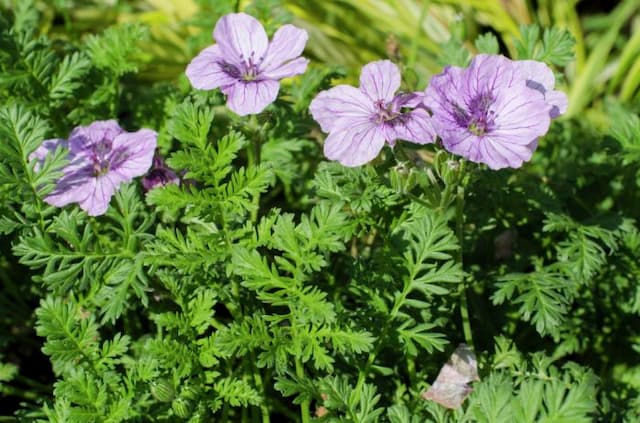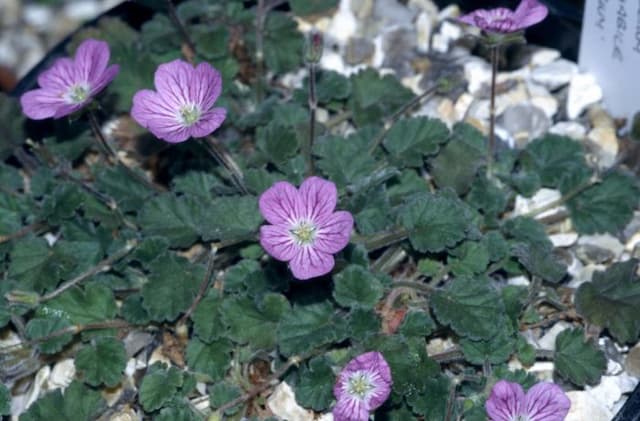Rock Geranium Erodium reichardii

ABOUT
Commonly known as Rock Geranium, this charming little plant features a mound of semi-evergreen foliage that is highly ornamental in nature. The leaves are close to heart-shaped, adorned with intricate, fern-like detailing, which creates an almost lacey appearance. This delightful foliage provides a lush backdrop for the plant's outstanding flowers. The Rock Geranium produces a profusion of blooms that can be described as tender and dainty. The flowers boast five petals, typically presenting in shades of soft pink with darker veining running through them, giving a sense of depth and texture. These petals are arranged in a loose cluster, often resembling a small bouquet, which adds to the plant's overall delicate allure. Contracting its gentle visage, the Rock Geranium is quite hardy and can serve as an alluring ground cover, filling spaces with its dense and low foliage. It typically blooms for an extended period, which could encompass much of the spring and summer, ensuring a long-lasting display of its endearing qualities. The combination of its lush foliage and fetching floral display makes Rock Geranium a treasured addition to rock gardens, borders, or as an ornamental flourish to any garden patch.
About this plant
 Names
NamesFamily
Geraniaceae
Synonyms
Alpine Geranium, Rock Geranium, Reichard's Cranesbill
Common names
Erodium corsicum, Erodium mouretii, Erodium reichardii subsp. corsicum.
 Toxicity
ToxicityTo humans
There is limited information available on the toxicity of Erodium reichardii, commonly known as Bishop's hat, to humans. It is not typically listed as a poisonous plant, and there are no well-documented cases or symptoms of poisoning in humans resulting from the ingestion of any part of this plant. As with any plant material, individual allergies or sensitivities might exist, so it is still wise to avoid ingesting plants not specifically meant for consumption.
To pets
Similar to the information regarding humans, there is limited data on the toxicity of Bishop's hat (Erodium reichardii) to pets. It is not commonly recognized as a toxic plant to pets such as dogs and cats, and there are no specific symptoms of poisoning associated with this plant reported in veterinary literature. However, since individual pets can have various sensitivities, it's generally recommended to prevent pets from ingesting plants not meant for their consumption. If a pet does ingest part of the plant and shows any signs of illness, a veterinarian should be consulted.
 Characteristics
CharacteristicsLife cycle
Perennials
Foliage type
Evergreen
Color of leaves
Green
Flower color
Pink
Height
0 feet 6 inches (15 cm)
Spread
0 feet 18 inches (45 cm)
Plant type
Herb
Hardiness zones
8
Native area
Mediterranean
Benefits
 General Benefits
General Benefits- Low Maintenance: Erodium reichardii, commonly known as Bishop's Form Alpine Geranium, typically requires minimal care once established, making it suitable for gardeners with limited time.
- Drought Tolerance: The plant is relatively drought-tolerant, which means it conserves water and can thrive in drier climates with less rainfall.
- Ground Cover: It can serve as an effective ground cover, filling in spaces and reducing the growth of weeds in your garden.
- Attracts Pollinators: The flowers of the Bishop's Form Alpine Geranium attract pollinators like bees and butterflies, contributing to the health of your garden ecosystem.
- Aesthetic Appeal: With its delicate pink flowers and attractive foliage, it adds beauty and visual interest to rock gardens, borders, and garden beds.
- Soil Erosion Control: As a ground-covering species, it helps prevent soil erosion by stabilizing the soil with its root system.
- Adaptable: It adapts to a wide range of soil conditions, though it prefers well-draining soils.
- Seasonal Interest: This plant offers seasonal blooms, enriching the garden with color and vibrancy during its flowering season.
- Compact Size: Its small, compact form makes it suitable for planting in small gardens, containers, or spaces with limited room.
 Medical Properties
Medical PropertiesThis plant is not used for medical purposes.
 Air-purifying Qualities
Air-purifying QualitiesThis plant is not specifically known for air purifying qualities.
 Other Uses
Other Uses- Erodium reichardii can be used as a living mulch in gardens due to its low-growing, dense foliage which helps in suppressing weeds and conserving soil moisture.
- This plant is suitable for butterfly gardens since it provides nectar for pollinators such as bees and butterflies, promoting biodiversity.
- In landscape design, Erodium reichardii is effective for softening edges and filling spaces between stepping stones, due to its spreading habit.
- It can function as a ground cover in coastal areas because it is tolerant to salt spray and can help stabilize sandy soils.
- Erodium reichardii's drought tolerance makes it a practical choice for xeriscaping, a landscaping method that reduces or eliminates the need for irrigation.
- Its low water requirements make it suitable for rock gardens where its ability to grow in crevices and shallow soil is advantageous.
- The plant can be used in green roofing, providing coverage, insulation, and visual appeal to roof gardens with low maintenance needs.
- Because of its compact size, Erodium reichardii is suitable for container gardening, adding texture and color to patios and balconies.
- As a decorative element in a miniature or fairy garden, its small-size and delicate flowers can create a whimsical, scaled-down landscape.
- The plant can be used in educational settings such as school gardens, to teach students about plant growth habits, ground cover species, and ecological gardening practices.
Interesting Facts
 Feng Shui
Feng ShuiThe Erodium reichardii, commonly known as Bishop's Hat, is not used in Feng Shui practice.
 Zodiac Sign Compitability
Zodiac Sign CompitabilityThe Bishop's Hat is not used in astrology practice.
 Plant Symbolism
Plant Symbolism- Determination: Erodium reichardii, commonly known as the Rock Cranesbill, often grows in rocky or sandy ground, symbolizing its ability to thrive in challenging conditions, representing determination and resilience.
- Adaptability: Rock Cranesbill's capacity to adapt to its environment is reflected in its symbolism, indicating versatility and the ability to prosper despite adversities.
- Delicacy: With its delicate and diminutive flowers, Rock Cranesbill embodies grace and a gentle nature, suggesting the presence of beauty even in rough landscapes.
 Water
WaterFor Heron's Bill (Erodium reichardii), moderate and consistent watering is key. Provide enough water to moisten the soil thoroughly while ensuring that the pot has good drainage to avoid waterlogging. In general, water Heron's Bill approximately once a week, but adjust the frequency depending on the humidity, temperature, and light conditions—more water may be needed in hot, dry weather and less in cooler, cloudy conditions. A rough estimate would be to provide about 8-16 ounces of water weekly, checking the top inch of soil for dryness before the next watering.
 Light
LightHeron's Bill thrives in bright, indirect sunlight. It's best positioned in a spot that receives partial to full sunlight, with protection from the harsh afternoon sun that could potentially scorch the leaves. East or west-facing windows are ideal as they offer plenty of light without the intensity of direct midday sun.
 Temperature
TemperatureHeron's Bill prefers a temperature range between 60°F and 75°F for optimal growth. It can tolerate temperatures down to about 30°F, but it should be protected from frost. Avoid exposure to temperatures above 80°F as this can stress the plant.
 Pruning
PruningPruning Heron's Bill is necessary to maintain its shape and encourage bushier growth. Prune lightly after the flowering season to remove spent flowers and any leggy growth. Doing so in the early fall allows the plant to prepare for the next blooming cycle. Regular deadheading during the blooming season will also promote more flowers.
 Cleaning
CleaningAs needed
 Soil
SoilAlpine Geranium prefers a well-draining soil mix with a pH range of 6.0 to 7.5. A mix of one part potting soil, one part coarse sand, and one part peat or compost would be ideal for promoting good drainage and aeration. Regular fertilization during the growing season will help maintain its health.
 Repotting
RepottingAlpine Geranium should be repotted every two to three years to refresh the soil and accommodate root growth. It's best done in the spring before the onset of the growth season.
 Humidity & Misting
Humidity & MistingAlpine Geranium thrives in moderate humidity levels but is quite adaptable. It doesn't require a strict humidity range, making it suitable for average home environments.
 Suitable locations
Suitable locationsIndoor
Provide bright light, well-draining soil, and moderate water.
Outdoor
Plant in well-drained soil; full sun to part shade.
Hardiness zone
5-8 USDA
 Life cycle
Life cycleErodium reichardii, commonly known as Bishop's Form Alpine Geranium, begins its life as a seed that germinates in spring when soil temperatures rise and moisture is present. Upon germination, it develops a rosette of leaves at the soil surface, followed by a taproot that anchors it into the ground. As it matures, it grows low to the ground, forming a dense mat of foliage that is evergreen in mild climates. Throughout late spring and summer, it produces small, five-petaled pink or white flowers that are pollinated by insects. After pollination, seeds develop in a distinctive form resembling a stork's bill, which eventually split open to disperse for the next generation. The plant reaches perennial maturity and will continue to grow and reproduce in this manner for several years, often with regular blooms each season if growing conditions are favorable.
 Propogation
PropogationPropogation time
Spring to summer
Propogation: Erodium reichardii, commonly known as Bishop's Form Alpine Geranium, is typically propagated by seed or by division. One of the most popular methods for propagating this plant is through seed sowing. Seeds can be sown in the spring after the last frost when soil temperatures rise, making for an ideal germination environment. To sow the seeds, prepare a well-draining seed starting mix and scatter the small seeds on the surface, pressing them gently into the soil without covering them, as they require light to germinate. Place the container in a warm location with bright, indirect light. Keep the soil consistently moist but not waterlogged. Germination usually occurs within a few weeks, after which you can transplant the seedlings to individual pots or your garden when they are large enough to handle and after the danger of frost has passed.



![Cranesbill [Blue Sunrise]](/_next/image?url=https%3A%2F%2Fplants-admin.emdemapps.com%2Fimages%2Fplants%2F%2Fimages%2F604b638d45948.png&w=640&q=75)





